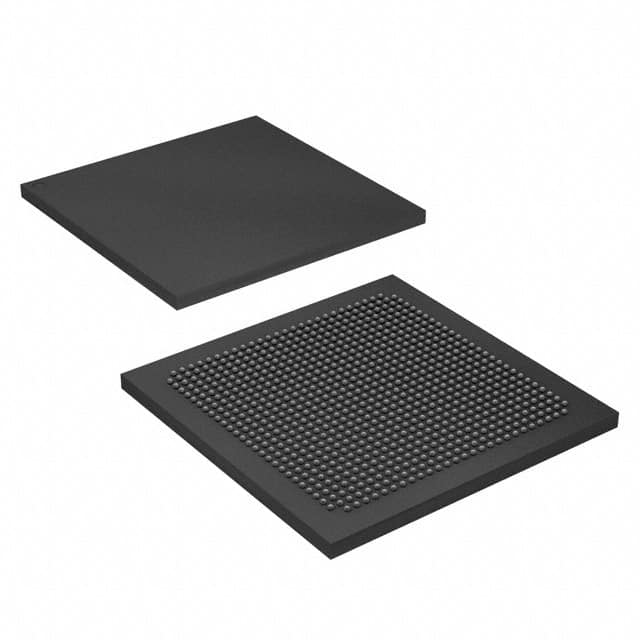Lihat spesifikasi untuk detail produk.

EP4SGX360FH29C4N
Product Overview
- Category: Integrated Circuit (IC)
- Use: Programmable Logic Device (PLD)
- Characteristics: High-performance, low-power consumption
- Package: 29mm x 29mm BGA package
- Essence: Field-Programmable Gate Array (FPGA)
- Packaging/Quantity: Individually packaged, quantity varies based on supplier
Specifications
- Manufacturer: Intel Corporation
- Family: Stratix IV GX
- Device: EP4SGX360FH29C4N
- Technology: 40nm
- Logic Elements: 360,000
- Embedded Memory: 14,112 Kbits
- Maximum User I/Os: 1,040
- Operating Voltage: 1.2V
- Operating Temperature: -40°C to +100°C
- Speed Grade: 4
Detailed Pin Configuration
The EP4SGX360FH29C4N has a complex pin configuration with various pins serving different functions. For a detailed pinout diagram and description, please refer to the manufacturer's datasheet.
Functional Features
- High-performance FPGA suitable for demanding applications
- Low power consumption for energy-efficient designs
- Large number of logic elements and embedded memory for complex designs
- High-speed transceivers for data communication
- Support for various I/O standards and protocols
- Flexible and reprogrammable architecture for design iterations
Advantages and Disadvantages
Advantages
- Versatile and adaptable for a wide range of applications
- High-performance capabilities for demanding tasks
- Low power consumption for energy-efficient designs
- Large amount of embedded memory for data storage
- Support for various I/O standards and protocols
Disadvantages
- Complex pin configuration may require careful planning and routing
- Limited availability of alternative models from other manufacturers
- Higher cost compared to simpler programmable logic devices
Working Principles
The EP4SGX360FH29C4N is based on FPGA technology, which allows users to program the device to perform specific functions. It consists of a large number of configurable logic elements interconnected through programmable interconnects. These logic elements can be programmed to implement various digital circuits and functions.
The device operates by configuring the internal connections and functionality using a hardware description language (HDL) or a graphical design tool. Once programmed, the FPGA executes the desired logic operations, enabling the implementation of complex digital systems.
Detailed Application Field Plans
The EP4SGX360FH29C4N finds applications in various fields, including:
- Telecommunications: Used in high-speed data communication systems, network routers, and switches.
- Aerospace and Defense: Employed in radar systems, avionics, and military-grade communication equipment.
- Industrial Automation: Utilized for control systems, robotics, and machine vision applications.
- Medical Devices: Integrated into medical imaging systems, patient monitoring devices, and diagnostic equipment.
- Automotive: Applied in advanced driver-assistance systems (ADAS), infotainment systems, and engine control units (ECUs).
Alternative Models
While the EP4SGX360FH29C4N is a highly capable FPGA, alternative models from other manufacturers can provide similar functionalities. Some alternative models to consider are:
- Xilinx Virtex-7 XC7VX485T-2FFG1761C
- Lattice ECP5-85F-6BG256C
- Microsemi SmartFusion2 M2S150-1FGG484I
These alternatives offer comparable performance and features, allowing designers to choose the most suitable FPGA for their specific requirements.
Note: The content provided above is a general overview and may not cover all aspects of the EP4SGX360FH29C4N. For detailed information, please refer to the manufacturer's datasheet and documentation.
Sebutkan 10 pertanyaan dan jawaban umum terkait penerapan EP4SGX360FH29C4N dalam solusi teknis
Sure! Here are 10 common questions and answers related to the application of EP4SGX360FH29C4N in technical solutions:
Q: What is EP4SGX360FH29C4N? A: EP4SGX360FH29C4N is a specific model of Field-Programmable Gate Array (FPGA) manufactured by Intel.
Q: What are the key features of EP4SGX360FH29C4N? A: EP4SGX360FH29C4N offers high-performance processing capabilities, large capacity for logic and memory, and support for various communication protocols.
Q: In what applications can EP4SGX360FH29C4N be used? A: EP4SGX360FH29C4N is commonly used in applications such as telecommunications, networking, industrial automation, video processing, and high-performance computing.
Q: How does EP4SGX360FH29C4N differ from other FPGA models? A: EP4SGX360FH29C4N stands out due to its high logic density, advanced DSP capabilities, and support for high-speed serial interfaces.
Q: Can EP4SGX360FH29C4N be programmed using industry-standard design tools? A: Yes, EP4SGX360FH29C4N can be programmed using popular design tools like Quartus Prime, which provide a user-friendly environment for FPGA development.
Q: What kind of performance can be expected from EP4SGX360FH29C4N? A: EP4SGX360FH29C4N offers high-speed processing with low latency, enabling real-time data processing and efficient algorithm implementations.
Q: Does EP4SGX360FH29C4N support multiple communication protocols? A: Yes, EP4SGX360FH29C4N supports various protocols such as Ethernet, PCIe, USB, HDMI, and DDR3/DDR4 memory interfaces.
Q: Can EP4SGX360FH29C4N be used for implementing complex algorithms or signal processing tasks? A: Absolutely! EP4SGX360FH29C4N's advanced DSP blocks and high-speed serial interfaces make it suitable for implementing complex algorithms and signal processing tasks.
Q: Are there any development boards available for EP4SGX360FH29C4N? A: Yes, Intel provides development kits like the Arria 10 GX FPGA Development Kit, which includes EP4SGX360FH29C4N and other necessary components for prototyping and testing.
Q: Where can I find technical documentation and resources for EP4SGX360FH29C4N? A: You can find detailed technical documentation, reference designs, and application notes on Intel's official website or their online community forums dedicated to FPGA development.

